CarEdge saved me over 4,500 dollars on a brand new Honda Pilot. I can't say thank you enough.
Price intelligence
Find a wide range of vehicle listings with market insights on new and used listings near you.


Help us personalize your CarEdge experience — it only takes a second.
Your answers help us personalize your CarEdge journey — we’ll follow up with tips and next steps that match your buying timeline.

As much as I love electric vehicles, their faults are not lost on me. Charging infrastructure lacks, service outside of warranty is costly, and most of all, they’re really expensive. Despite the hurdles facing EVs in 2022, a new Bank of America Merrill Lynch Car Wars study predicts that EVs, PHEVs and hybrids will make up 60% of new models in 2026. With so many new electric cars coming making debuts in 2023 and 2024, time is running out to prepare the masses for the big changes ahead.
Every year, Bank of America Merrill Lynch releases their cleverly-named Car Wars report. The report leverages the bank’s access to big data to forecast automotive industry trends like no other. In the 2022 Car Wars Report, John Murphy, a senior auto analyst at Bank of America Merrill Lynch, told Automotive News that he expects automakers to launch roughly 245 new models over the next four years. That averages out to 61 new models per year — 50 percent higher than the average over the past two decades.
Why the flood of new car models? Simply put, new powertrains inspire new models. No one wants to retrofit a billion-dollar electric powertrain onto a decades-old chassis.
Analysists took the strategies of each major automaker into consideration and shared their market share forecasts for model year 2025. Notably, Stellantis and Nissan are forecast to lose market share despite funneling billions of dollars into new electrified models. General Motors, Honda and European brands are forecast to maintain steady market share in the U.S. market. With the upcoming Silverado EV, Cadillac Lyriq and Equinox EVs just around the corner, it’s not what automakers like to hear at such a crucial moment.

The automakers with the highest model replacement rate fared best in the Car Wars analysis. Ford, Toyota and the Korean automakers have the highest expected replacement rate, and therefore are expected to gain market share.
However it’s what Bank of America thinks about Tesla that’s drawing headlines.

In the annual Car Wars study, Bank of America Merrill Lynch senior auto analyst John Murphy predicts that Tesla’s EV market share will drop from over 70% today to just 11% in 2025. That’s the most pessimistic Tesla forecast we’ve seen in a few years, harkening back to when talking heads from legacy automakers regularly predicted doom and gloom for Tesla.
Why the forecasted 60% drop in market share? Murphy cites the massive push to electrification from the likes of Ford, General Motors, Hyundai and Kia. It’s not clear if Murphy considered the significance of Tesla’s Supercharger Network, top-notch over-the-air update capabilities and high brand loyalty in his forecast. What do you think?
Looking for EV sales numbers? July is here, and that means the second quarter of 2022 has come to an end. As automakers release their Q2 2022 EV sales numbers, be sure to check the latest updates and statistics at CarEdge’s EV market share and vehicle sales report.
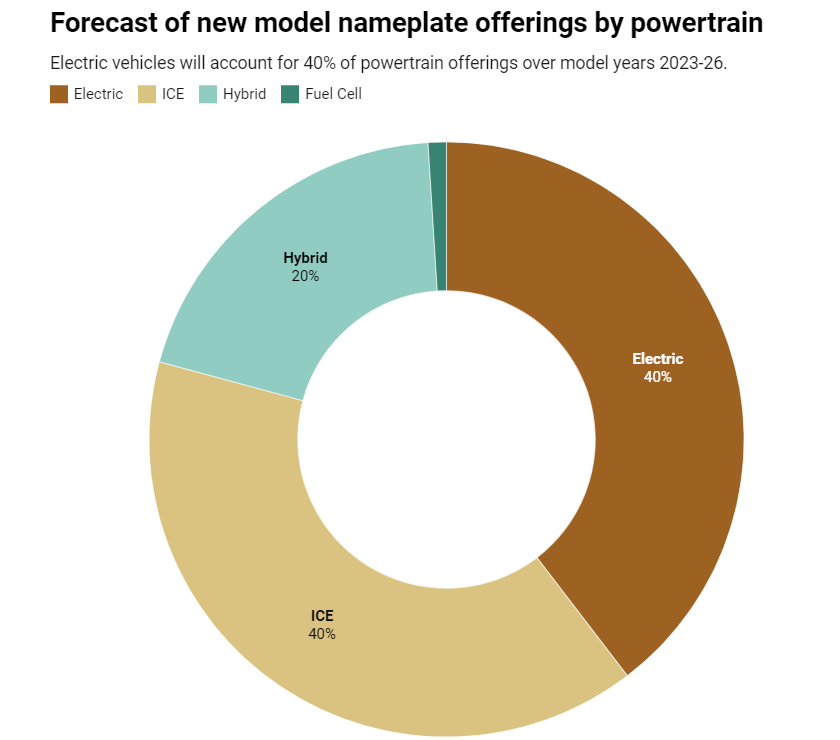
Of the new models introduced between 2023-2026, 60 percent will be either electric or hybrid while 40 percent will be internal combustion. Among notable 2023 electric cars just around the corner are electric trucks, sedans, and a whole lot of crossovers.
Headline-grabbing claims aside, this EV market share forecast is in line with much of the industry’s thinking. In fact, automakers are sure to hope that these numbers become reality, as they are actively investing a cumulative total of roughly $500 billion dollars in electrifying their lineups.
With high-stakes new electric cars in 2023, legacy automakers are definitely taking EVs seriously. Which 2023 electric car are you most excited about?

As drivers warm up to the idea of going electric, every electric vehicle recall is sure to turn heads, regardless of severity. 2022 is a huge year for automakers unveiling their next generation of electric vehicles. With over half a trillion dollars invested in EVs, there’s a lot riding on the success of these new arrivals. Several electric vehicle models have already been subjected to recalls. Fortunately, most of them do not directly involve electric powertrains. These are the EVs facing recalls in 2022. We’ll update this page as future recalls are inevitably announced.

October 2022 – Rivian recalled every vehicle it has produced, including all R1T electric trucks, R1S electric SUVs, and EDVs produced for Amazon. The vehicles were recalled because of concerns that a bolt in steering assemblies wasn’t sufficiently tightened.
No accidents have been reported, but the recall is still causing massive headaches for the young automaker. The recall fix is already available, it’s as simple as tightening a (very important) screw. However, the challenge lies in the limited locations of Rivian Service Centers. For example, the state of Texas has one service center in Houston. There are just 5 Rivian service centers on the entire East Coast. Most locations are in California. See the full list of locations.
Fortunately, Rivian has mobile service technicians, but they’ll surely have their hands full. See additional details on the Rivian recall here.
June 23, 2022 – The Toyota bZ4x and Subaru Solterra are EV siblings co-developed by the two Japanese automakers. Just a month into deliveries, the two models have been recalled globally due to an issue with their wheel hub bolts that could in fact cause the wheels to fall off. Fortunately, the issue does not involve Toyota and Subaru’s brand-new electric powertrain.
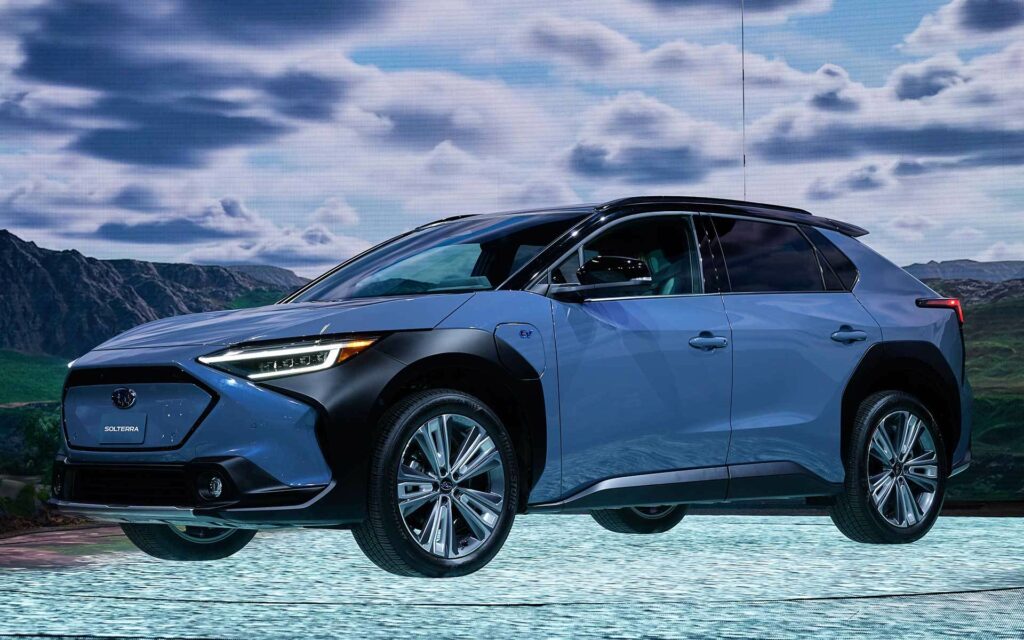
The US National Highway Traffic Safety Administration (NHTSA) recall notice warns owners not to drive their vehicles until they are repaired. This isn’t a good look considering the significance of Toyota’s first all-electric vehicle. A bZ4X and Solterra recall remedy is currently under development according to the US NHTSA.
“The cause of the issue and the driving patterns under which this issue could occur are still under investigation,” the notice says.
The recall affects 2,700 bZ4x models and 2,600 Solterras globally. See if your Toyota bZ4X VIN number is subject to the recall at Toyota’s official recall page. You can check if your Subaru Solterra is impacted at Subaru’s official recall site.
June 27, 2022 – The electric F-150 Lightning is the most-anticipated new model making a debut this year. Ford Motor is recalling 2,906 F-150 Lightnings because of a software issue that could result in a failure to provide low tire pressure warnings. The 200,000 F-150 Lightning reservation holders are certainly relieved to find that this recall is not related to Ford’s all-new electric powertrain.
In this particular recall, simple human error is at fault. Ford says that the recommended tire cold inflation pressure was incorrectly set to 35 psi instead of 42 psi. No accidents have resulted from this F-150 Lightning recall, but it’s the fix that’s noteworthy. The recall gives Ford a publicized opportunity to show the world that the F-150 Lightning is OTA capable. Over-the-air updates, first implemented on a large scale by Tesla, are no easy feat. Plenty of automakers can update navigation and infotainment via OTA update, but few are capable of firmware OTA updates that tinker with the powertrain.
Learn more about how over-the-air updates are changing how cars get serviced.
F-150 Lightning Recall Fix: Those who wish to receive the recall fix immediately may head to a Ford dealership service center immediately. Otherwise, Ford says the over-the-air update will be available to download via home WiFi within a few weeks. Check to see if your F-150 Lighting VIN number is impacted by the recall at Ford’s official recall page.

May 13, 2022 – As an IONIQ 5 owner myself, I was not thrilled to see the first manufacturer recall coming in one month into ownership. The US National Highway Traffic Safety Administration (NHTSA), Hyundai and Kia have announced a recall for select VIN numbers of the 2022 model year Hyundai IONIQ 5 and Kia EV6.
The IONIQ 5 and EV6 share Hyundai Motor Group’s new e-GMP electric platform. The recall is for the potential for disruptions to the vehicle’s parking actuator system when the vehicle is off. Sudden voltage fluctuations may occur while the vehicle is off, potentially causing the parked vehicle to disengage from ‘Park’ momentarily. If this occurs while the vehicle is parked on uneven terrain, vehicle rollaway is possible.
IONIQ 5 and EV6 recall fix: A fix is already available, but you’ll have to visit your Hyundai or Kia dealership service center. I just got the recall fix done at my local Hyundai dealer. They had never seen an IONIQ 5 before, and one employee asked if I was coming in for an oil change. Nevertheless, I was in and out of the dealership in about 30 minutes.
Check to see if your Hyundai IONIQ 5 is involved in this recall at Hyundai’s official recall page. You can see if your Kia EV6 is impacted at Kia’s official recall page.
Learn more about the IONIQ 5 recall here. Unfazed by the recall and looking to buy an IONIQ 5? Here’s how I found a Limited AWD IONIQ 5 at MSRP. It wasn’t easy.
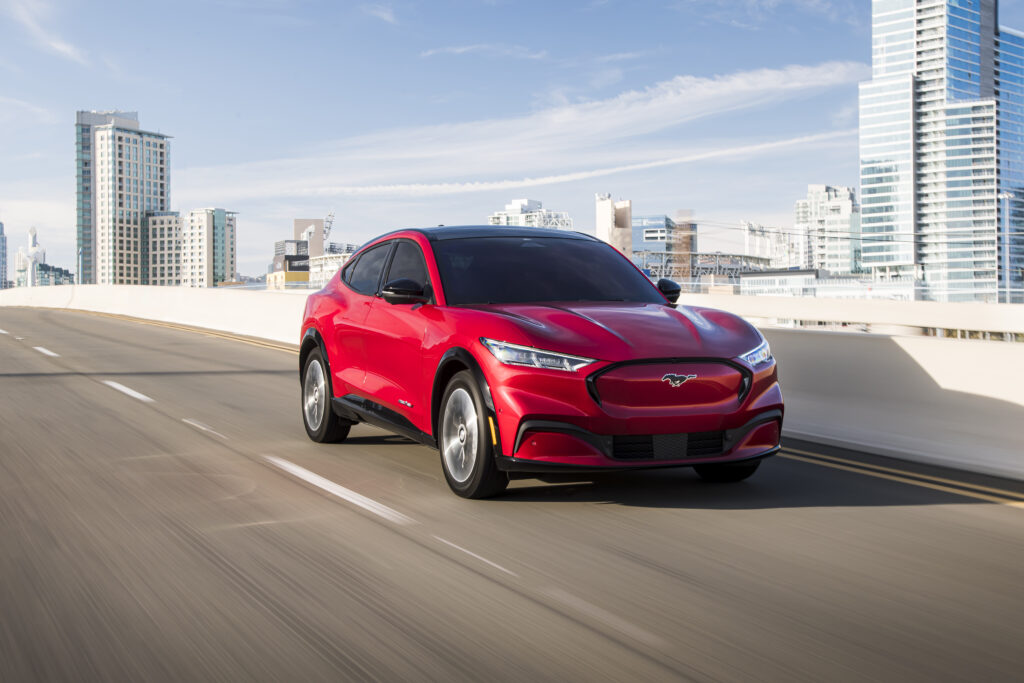
June 14, 2022 – Ford is recalling all 50,000 Mustang Mach-E electric crossovers because of the risk of power loss. The possible power loss could occur while the vehicle is in motion or parked.
The recall is due to problems with the Mustang Mach-E’s battery contactor, which is a switch that determines which vehicle components the battery sends power to. Interestingly, the power loss is more likely to occur when putting the pedal to the metal for maximum acceleration, according to Ford. If power loss occurs, a powertrain malfunction warning light will illuminate on the dashboard, and the vehicle will display “Stop Safely Now’ in the gauge cluster behind the steering wheel. Clearly, it’s time to pull over immediately with a message like that.
Ford Mustang Mach-E recall fix: Ford has pursued Tesla in more ways than one. In addition to ending EV lease buyouts and going for direct-to-consumer sales via Ford Model e, Ford has brought over-the-air updates to its lineup. Ford says that Mustang Mach-E owners will receive an over-the-air update sometime in July to install a software remedy for the recall. Until then, a stop-sale is in place.
Learn more about the Ford Mustang Mach-E recall at Ford’s official recall page.
Several hundred automotive recalls happen every year across vehicle classes and powertrains. There will surely be more to come. What we’ll be keeping an eye on is how the latest electric powertrains are performing. Luckily, most of the EV recalls to date have been for components other than the electric powertrain. However, we all remember how the Chevrolet Bolt recall and fire hazard tarnished GM’s reputation. Check back for the latest updates!
Between 500 and 800 auto recalls are issued every year, affecting tens of millions of American vehicles. In fact, recalls have become so common that many drivers simply ignore them, which is a dangerous move. Fortunately, some automakers are making it possible to address recalls from the comfort of home. Ford’s F-150 Lightning electric truck is now subject to a recall, and Ford’s Blue Oval Intelligence feature is making the fix easier than ever before. But make no mistake: Ford’s over-the-air update capability has roots in Tesla’s decade of success.
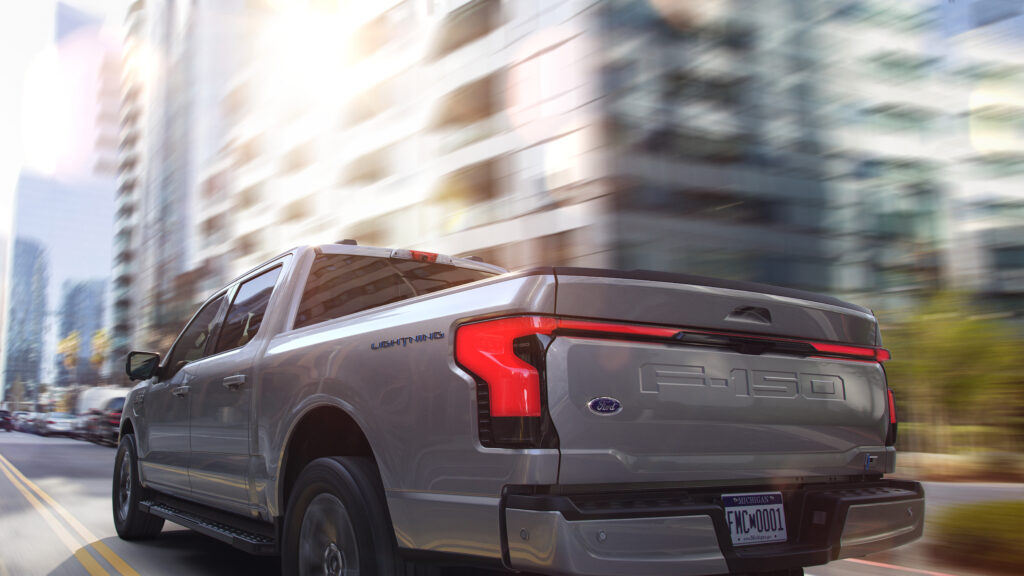
Ford Motor said Monday it will recall 2,906 F-150 Lightnings because a software issue could result in a failure to provide warning of low tire pressure. The 200,000 F-150 Lightning reservation holders are certainly relieved to find that this recall is not related to Ford’s all-new electric powertrain. In this particular recall, simple human error is at fault. Ford says that the recommended tire cold inflation pressure was incorrectly set to 35 psi instead of 42 psi.
No accidents have resulted from this F-150 Lightning recall, but it’s the fix that’s noteworthy. The recall gives Ford a publicized opportunity to show the world that the F-150 Lightning is OTA capable. Over-the-air (OTA) updates have long been a top selling point of Tesla’s electric vehicles. By enabling vehicle software updates over a home wifi internet connection, OTA updates are convenient for both drivers and automakers alike.
Here’s our complete guide to automotive over-the-air updates, and what they mean for your car.
Ford’s first OTA updates were rolled out to the Mustang Mach-E in 2021. As successful as the Mustang Mach-E has been for Ford, the F-150 Lightning is on another level with hundreds of thousands of reservations, and unruly dealer markups souring its reputation to some.
To date, Ford has demonstrated its ability to send software over-the-air updates to its electric vehicles. Software OTA fixes are not as transformative as the firmware OTA fixes that Tesla has implemented. On numerous occasions, Tesla has sent OTA updates that addressed aspects of charging, acceleration, efficiency and range. We’ve yet to see Ford implement firmware OTA updates, but the automaker claims that Blue Oval Intelligence will be capable of doing so when the need arises.
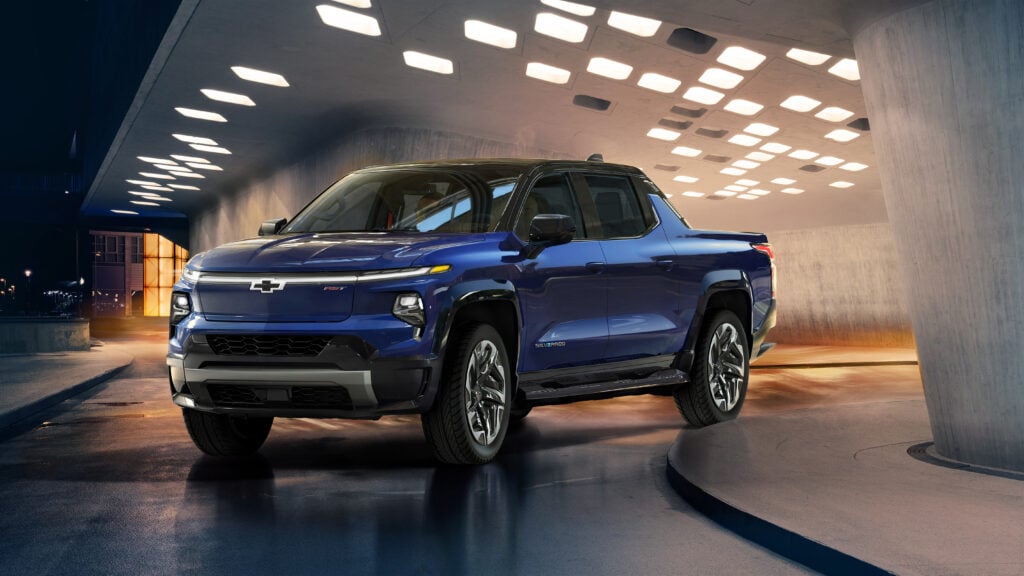
In 2022, just about every automaker claims to be bringing over-the-air updates to their future lineups. General Motors was an early pioneer of OTA updates, having tried it out with OnStar way back in 2009. The second generation of GM’s OTA updates was launched in 2019 as Vehicle Intelligence Platform (VIP). VIP now enables OTA updates for nearly every vehicle control module, not just infotainment. GM’s latest software platform is advancing OTA update capability to new heights. Ultifi is designed to provide more frequent OTA updates, similar to how Tesla owners are accustomed to.
Other legacy automakers are a bit behind the curve. The likes of Hyundai, Honda, BMW, Mercedes-Benz and Volkswagen group are all offering OTA updates for infotainment and navigation, but not much else at the moment. Electrek has a great breakdown of each automaker’s plans for OTA updates.
Chinese automaker NIO is reportedly planning to enter the American market with several OTA-capable models. NIO’s over-the-air update capabilities are second only to Tesla, with firmware-updates proven in the automaker’s overseas markets. NIO is more widely known for their battery swapping stations, which replace the need to wait around for a charge. Learn more about NIO coming to America.
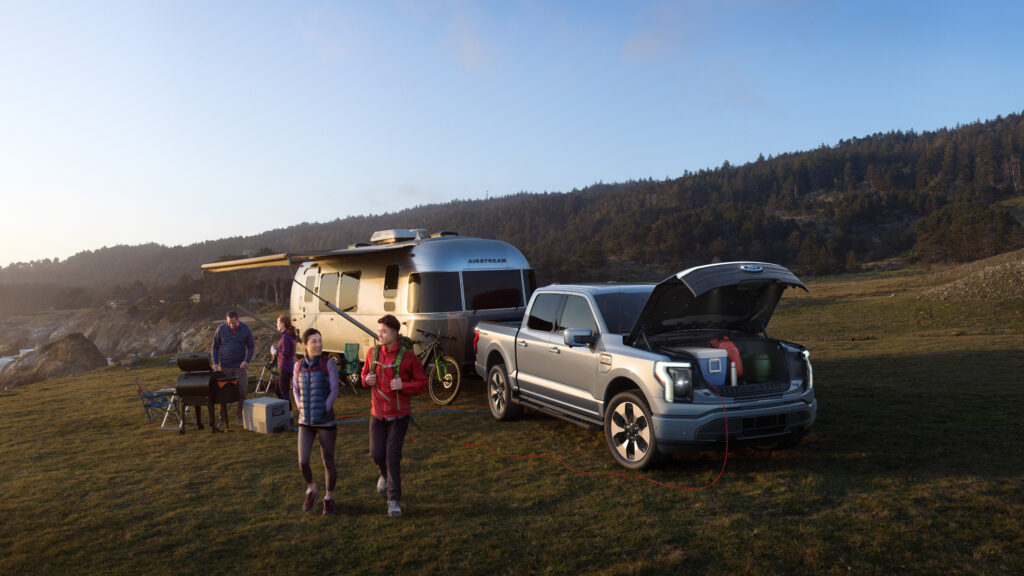
With up to 320 miles of range, decent charging speeds, powerful towing capabilities and the option of using the truck’s battery as a home generator, there’s a lot to love about the F-150 Lightning. What we don’t love are the dealer markups that have been making headlines for all the wrong reasons. Is the F-150 Lightning a great deal at $40,000 to $90,000? Certainly. When dealers start adding $50,000 markups to this truck, it’s not doing the EV movement any favors.
Learn more about the F-150 Lightning’s specs and pricing.
Looking to buy? See nationwide dealer listings for the F-150 Lightning at CarEdge Car Search.
Let us know what you think. Is the F-150 Lightning comparable to a Tesla, or is it too early in the game to make such bold claims? How much would you pay for an electric work truck? Are EV incentives enough for you to make the switch? Let us know!

What if I told you that auto dealerships are one of the largest political forces in the United States? To dealerships both big and small, business is about a lot more than selling cars. There are 17,968 new car dealerships in the United States, a figure that has grown at the same time that vehicle inventory has plummeted, and new car prices have skyrocketed. As the price of a new vehicle rises out of reach for millions more American consumers, many are reporting all-time record profits.
How did dealerships come to exert such a massive influence on the economy and politics of the United States? To find out, we’ll take the backroads of America to bring this fascinating story of power and influence into the spotlight. Nine out of ten American households own a car, and 55% of autos are purchased at a dealership. This is the tale of how we got here.

As the automotive industry was born in the late nineteenth and early twentieth centuries, automakers faced a dilemma. They had figured out how to engineer and produce a transformative product, but how would they deliver and service these first automobiles? Better yet, who would educate the consumer about vehicle ownership?
It’s important to remember that automakers were selling what they called ‘horseless carriages’ to customers at the time. The majority of the population knew nothing of internal combustion engines. In the first and second decades of the twentieth century, automobile adoption picked up pace. How would an ordered vehicle get to a customer’s hands? Who would service these ‘motor carriages’? Would the customer foot the bill for repairs, or would the automaker offer a warranty? These are just a few of the questions up for debate when the car dealer distribution model was conceived.
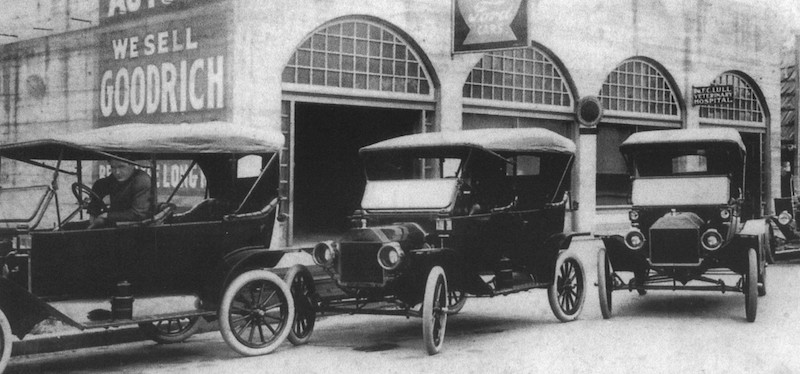
It took a few decades for the logistics of car distribution to get worked out. Not everyone was on the same page, and some pushed for solutions modeled after other industries. In fact, some early ideas sound ludicrous to us today. Many early auto industry players advocated for a mail order service modeled after the successes of Sears & Roebuck and Montgomery Ward. But that left too many questions unanswered for a young industry that was eager to get it right. Despite the world-changing invention at hand, automakers still feared their own demise. Considering how few of the early automakers have persisted to this day, their fears were not unfounded.
The first dealership in the United States was established in 1898 by William E. Metzger, who sold Oldsmobiles in Detroit. Over the next two decades, the dealership model rose to prominence, slowly overcoming competing automobile sales models. In 1917, the now-famous National Auto Dealers Association (NADA) was established with the goal of giving car dealers a voice in Washington.

Today, the NADA is a nationally-recognized industry and political force that represents over 16,000 auto dealers nationwide. However, one of America’s most powerful lobbies had humble beginnings rooted in the turmoil of a wartime economy.
The NADA was founded in 1917 when a group of dealers set out to change the way Congress viewed the emerging automobile industry. Thirty dealers from state and local associations succeeded in convincing Congress that cars weren’t ‘luxuries’ as they had been classified in the federal tax code. By convincing lawmakers that cars were vital to the economy, the group prevented the conversion of young automobile manufacturing facilities into wartime factories. The so-called ‘luxury tax’ that had been levied on cars was reduced from 5 percent to 3 percent.
In essence, the NADA has been lobbying since the very beginning. And they’re good at it. From 1919 to the present day, the group spearheaded hundreds of legislative priorities that served the interest of the ever-growing number of car dealers in the United States.
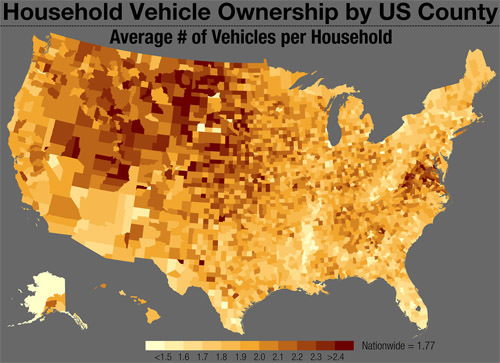
In American car culture, cars are central to the economy and most of our day-to-day lives. In 2020, 91% of American households owned at least one car, a figure that continues to grow. Where do the 276 million registered vehicles in the U.S. come from? Tesla and Rivian aside, it’s almost always from a local dealer.
State dealer associations are prominent organizations around the country. The Florida Automobile Dealers Association has over 1,000 dealer members, and dozens of other states have associations of similar size. Political action begins at the grassroots level, and this is where state dealer associations flex their muscle.
State auto dealer associations provide networking opportunities for professionals, a regional dealer support system, and a venue for working out solutions to challenges. There’s also the unified political voice that lobbies at the local, state and nationwide levels. Lobbying costs money, both in the form of employing professional lobbyists, and in lawmaker donations. I’ll scratch your back if you scratch mine? Dealer industry associations have shown time and time again that their lobbyists achieve the desired outcome more often than not.
A recent example of what’s possible at the state level comes in the form of an emerging legislative push that’s troubling for any electric vehicle owner or prospective buyer. In 2022, bills were introduced in both Oklahoma and West Virginia that would ban over-the-air (OTA) updates. Why? Car dealer lobbying groups are doing their best to keep drivers returning to dealer service centers for repairs. Tesla’s pioneering OTA updates have revolutionized everything from performance upgrades via wifi to recall fixes from the comfort of home.
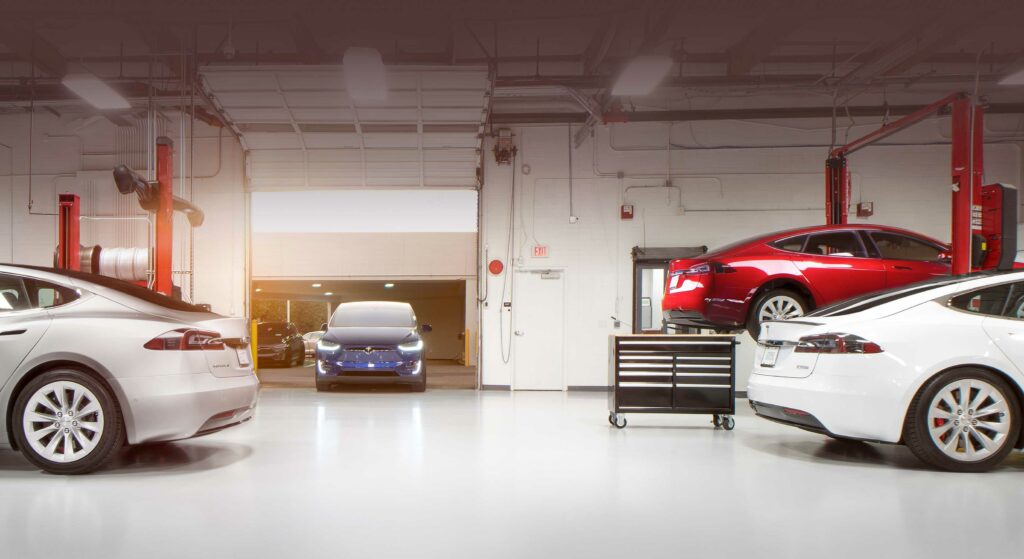
Why would dealership lobbying groups have a bone to pick with OTA updates? Service center visits account for nearly half of total dealership revenue, with some locations relying heavily on service to stay profitable. The electrification of the auto industry is here, and resistance to OTA updates is just a sign of what could be around the corner.
Online car sales have disrupted the industry over the past decade, with the likes of Carvana and Vroom seemingly coming out of nowhere. Their entrance hasn’t been without problems. Carvana is under pressure for repeatedly failing to transfer vehicle titles in a timely manner. The solution? A Florida state senator took the time to hand-craft legislation to simply remove the requirement to provide the title at all. If that’s not motivated by state-level dealer lobbying, I don’t know what is.
Over 1.2 million Americans are employed at the nearly 18,000 franchised car dealerships and 60,000 independent dealerships in the United States. The power of dealerships is very much rooted in the economy of the nation. However, this power is not evenly distributed. In many communities, particularly in small-town America, dealerships have an oversized role in the local economy.
Jim Lardner, spokesperson for Americans for Financial Reform, told David Dayen of The Intercept that communities sometimes even rely on the economic powerhouse of locally owned and operated dealerships. “They sponsor Little League teams. Their advertising dollars are crucial to local newspapers and broadcasters. When they talk, lawmakers don’t just listen — they have a hard time hearing anybody else or looking at facts.”
As is often the case, with more economic power comes the appetite for political power. Sure, probably not for the sake of power itself, but to have a say in the rules of the game.

The National Auto Dealers Association has delivered $35 million to members of Congress since 2022. The NADA maintains a large lobbying operation in DC, one that costs $3 million a year to operate. The power of dealers is not limited to the doings of the NADA and state-level associations. In a recent election cycle, 372 of 435 members of the House of Representatives received campaign contributions (money) from auto dealers. 57 out of 100 senators could say the same.
On a national level, the NADA has collaborated with the Alliance of Automobile Manufacturers and even the American Financial Services Association to push favorable legislation. In 2015, a rare bipartisan bill was a textbook example. The bipartisan bill amounted to a stand-down order to the Consumer Financial protection Bureau (CFPB). Shouldn’t lawmakers be standing up for the consumer, not the opposite?
It gets worse. The CFPB was established in 2011 to protect consumers to promote “transparency and consumer choice and prevent abusive and deceptive financial practices. It was partially in response to what we all went through in the 2008 financial crisis. When the CFPB was created, a special provision was added last-minute just for nervous dealers. This provision, which is enshrined in CFPB regulations, says that the agency itself can NOT directly monitor dealerships. As David Daley notes in his wonderful piece in The Intercept, “the CFPB can only fine the lenders who finance car purchases, not the dealers who make the markups”.
This is one of many examples of auto dealers wielding their power to influence laws and regulations in their favor. The secret to their success is something called legislative riders. Riders are provisions or ‘add-ons’ that can be added to a bill last-minute, often with hopes of its controversial aspects being buried in the hundreds or thousands of pages of more newsworthy text. The West Virginia OTA ban that was proposed and later removed is one such example. It was conveniently tucked into a much larger pro-dealer bill.

Record new and used car prices from 2021 to 2023 soured consumer sentiment. Dealer markups regularly reached beyond $10,000, and more car buyers turned to Tesla and other direct-to-consumer automakers to steer clear of the dealership experience. Nine out of ten Tesla buyers cite the no-hassle direct-to-consumer sales model as a major factor in their buying decision. Now, legacy automakers are testing the waters too.
In 2022, Ford made headlines with the announcement that it would split into two new companies under the Ford Motor Company umbrella: Ford Blue for combustion sales, and Ford Model e for electric vehicle sales.

Ford Model e transforms Ford’s electric vehicles sales model to something between direct-to-consumer and the traditional dealership model. There will be no-haggle set pricing, online ordering, but dealers will continue with a role as delivery, test drive and service centers. If you haven’t connected the dots, Ford is taking a few big steps away from the past century of traditional dealership sales. Will other automakers follow?
Mercedes-Benz and BMW are beginning to test what they call agency sales in Europe. Essentially, it’s the same concept as Ford’s Model e business model. Are the floodgates opening in the push to direct-to-consumer sales? We’ll know soon enough.
Car dealerships are powerful economic and political forces in America. The birth of American car culture parallel to the rise of the dealership lobby was no coincidence. However, times are changing. Can dealers lobby their way out of an industry that is evolving at breakneck speed? What will buying a vehicle look like a decade from now? Unknowns abound, but one thing is for sure: the salespeople out front are eagerly awaiting your arrival.
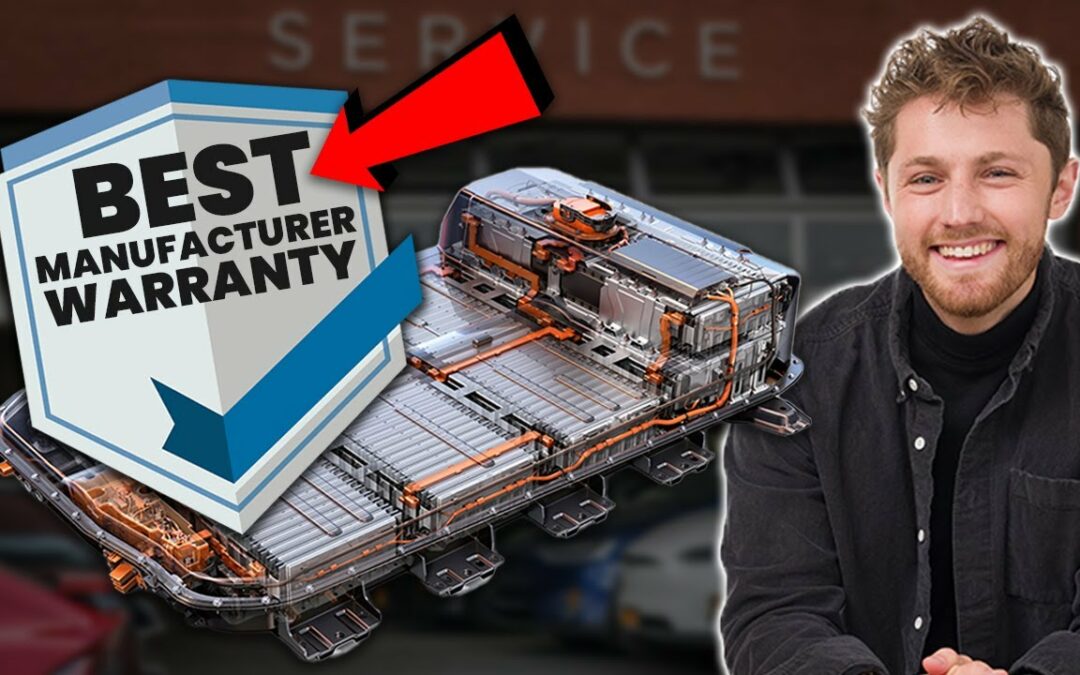
Electric vehicle batteries are expensive to replace — often $10,000 to $20,000 for a fully electric car. While battery costs are expected to drop in the coming years, today’s EV drivers need strong warranty coverage to protect their wallet.
By federal law, all EV and hybrid batteries must be covered for at least 8 years or 100,000 miles. In California, that coverage extends to 10 years or 150,000 miles. But not all warranties are created equal. Some go further than others when it comes to battery degradation, replacement criteria, and coverage for second owners.
So, which EV brands offer the most comprehensive battery warranties in 2025? The top spot might surprise you.
Rivian (8 years or 175,000 miles)
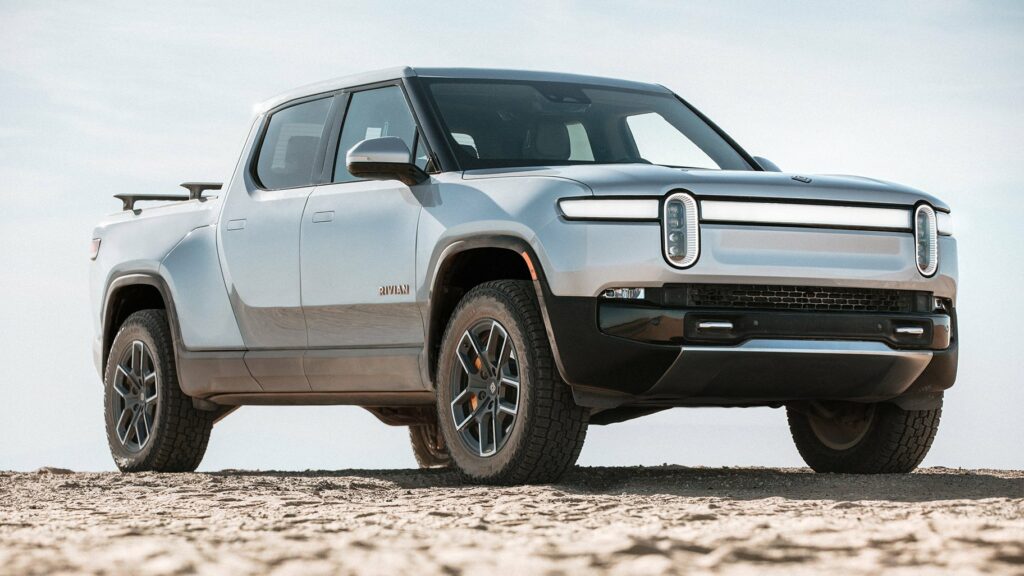
Surprise! The best EV warranty is offered by Rivian for the all-new R1T electric truck and R1S electric SUV. Coverage includes all components inside the high-voltage battery and 70% or more of the battery capacity for 8 years or 175,000 miles, whichever comes first.
Drivetrain components are also covered for 8 years or 175,000 miles. It can be unnerving to purchase a vehicle from a startup like Rivian, so at least they’re offering the best battery warranty there is. Learn more about Rivian’s warranty here.
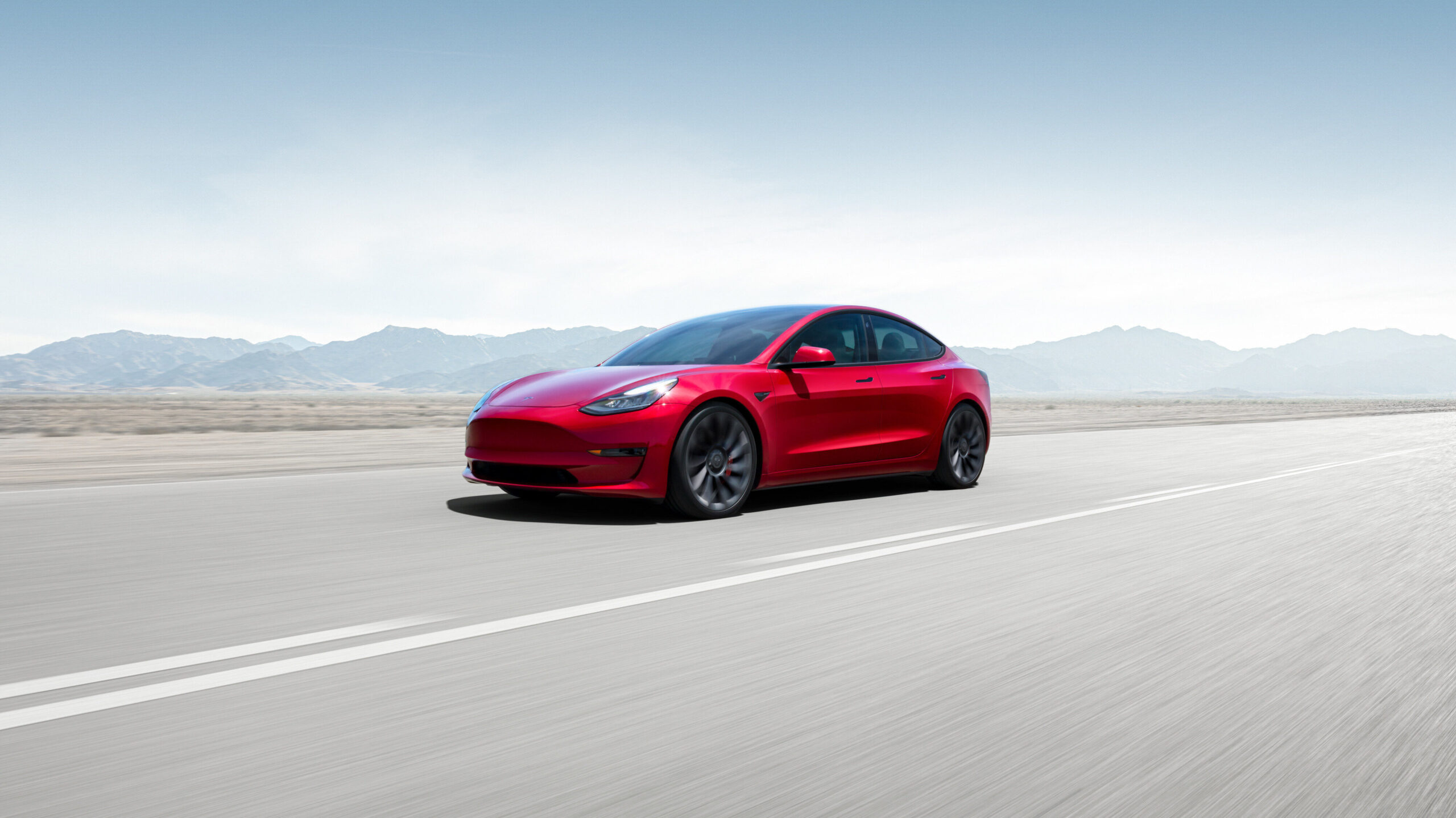
Tesla’s electric powertrain warranty is split into two tiers.
Learn more about Tesla’s battery warranty.
Hyundai and Kia (10 years or 100,000 miles)
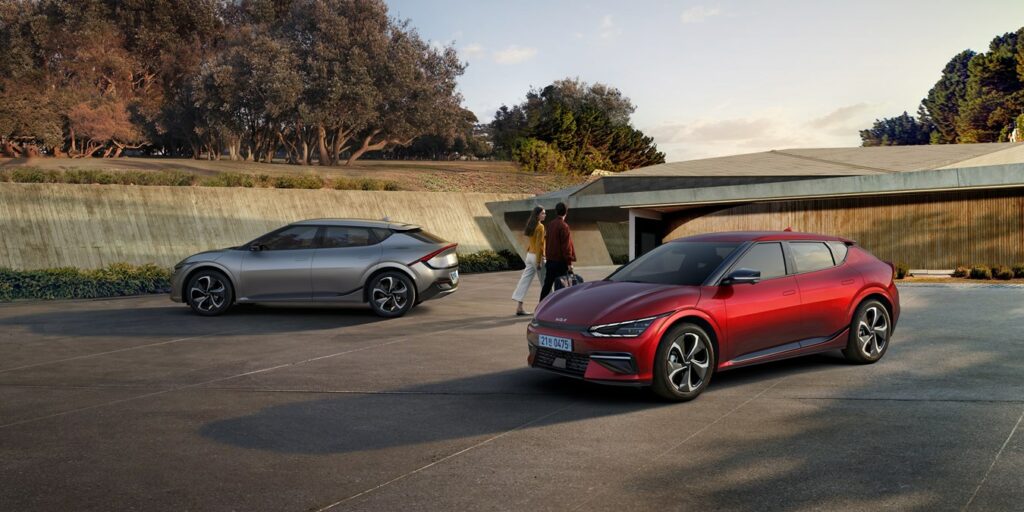
When shopping affordable EVs, you can’t beat Hyundai and Kia’s 10 year/100,000 mile EV warranty. The Hyundai EV warranty covers batteries, motors and powertrain components. There’s also the guarantee of at least 70% battery capacity retention. Hyundai lays it out clearly: “While all electric-car batteries will experience degradation over time, ours will not degrade more than 70 percent of the original capacity during the warranty period.”
Learn more about Hyundai’s electric vehicle battery warranty. You can find Kia’s EV warranty details here.
In 2025, it looks like the industry standard for EV manufacturer warranties is 8 years or 100,000 miles, whichever comes first. This manufacturer warranty applies to the following electric vehicles in 2024:

GM electric models like the Chevrolet Equinox EV, Blazer EV, and Cadillac Lyriq have 8 year/100,000 mile battery warranties with a notable catch. The battery retention portion of the warranty will replace the battery if it falls below 60% of the original capacity under coverage. See the full details here.
Q: What do EV battery warranties cover?
A: Most EV battery warranties cover defects in materials and workmanship, as well as capacity loss beyond a certain threshold (usually 70% of the original capacity). If your battery fails or degrades too quickly, it should be repaired or replaced under warranty.
Q: How long are EV battery warranties?
A: Federal law requires at least 8 years or 100,000 miles of coverage. In California and other CARB-aligned states, coverage extends to 10 years or 150,000 miles. Some automakers go above and beyond these minimums.
Q: Who has the best EV battery warranty in 2025?
A: As of 2025, Hyundai and Kia offer some of the most generous EV battery warranties, with 10-year/100,000-mile coverage that includes transferable protection and specific degradation thresholds. Tesla, Ford, and Toyota also offer strong warranties, but terms vary, especially for used EVs.
Q: Do EV battery warranties transfer to new owners?
A: In many cases, yes — but not always. Some automakers offer fully transferable warranties, while others reduce or void coverage after resale. Always confirm the terms before buying a used EV.
Q: Can I get extended protection for my EV battery?
A: Yes. If you plan to keep your EV long-term, an extended warranty can provide added peace of mind. With CarEdge extended warranty plans, you can cover high-cost components like the battery and electric motor after the factory warranty ends.
CarEdge is a trusted resource for car buyers, offering data-backed insights, negotiation tools, and expert guidance to help consumers save time and money. Since 2019, CarEdge has helped hundreds of thousands of drivers navigate the car-buying process with confidence. Learn more at CarEdge.com.